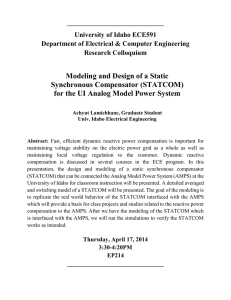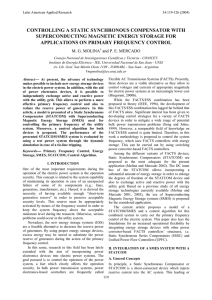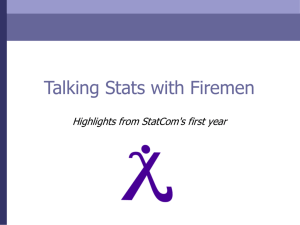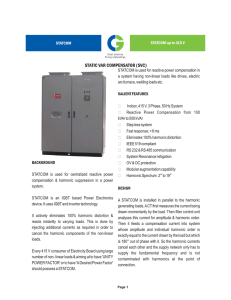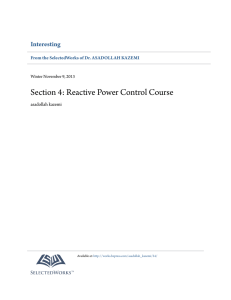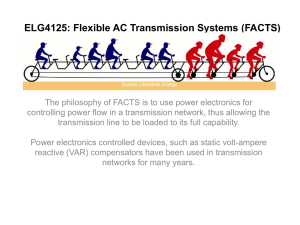Wind system using Static Synchronous Compensator Technology
advertisement
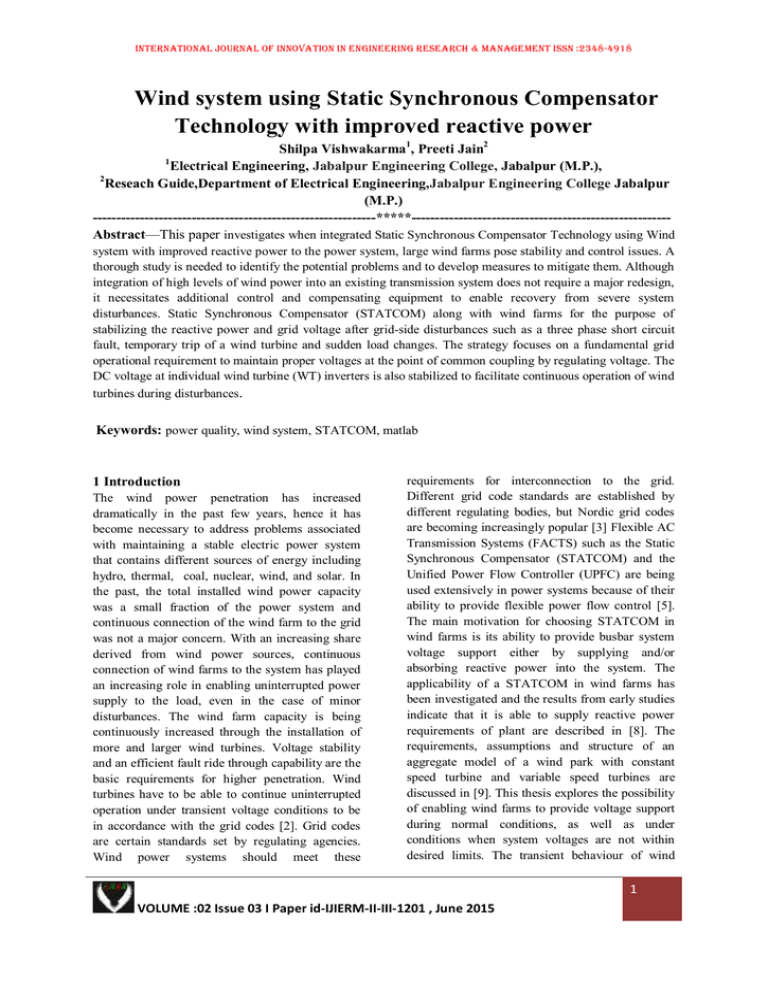
INTERNATIONAL JOURNAL OF INNOVATION IN ENGINEERING RESEARCH & MANAGEMENT ISSN :2348-4918 Wind system using Static Synchronous Compensator Technology with improved reactive power Shilpa Vishwakarma1, Preeti Jain2 Electrical Engineering, Jabalpur Engineering College, Jabalpur (M.P.), 2 Reseach Guide,Department of Electrical Engineering,Jabalpur Engineering College Jabalpur (M.P.) ------------------------------------------------------------*****------------------------------------------------------Abstract—This paper investigates when integrated Static Synchronous Compensator Technology using Wind 1 system with improved reactive power to the power system, large wind farms pose stability and control issues. A thorough study is needed to identify the potential problems and to develop measures to mitigate them. Although integration of high levels of wind power into an existing transmission system does not require a major redesign, it necessitates additional control and compensating equipment to enable recovery from severe system disturbances. Static Synchronous Compensator (STATCOM) along with wind farms for the purpose of stabilizing the reactive power and grid voltage after grid-side disturbances such as a three phase short circuit fault, temporary trip of a wind turbine and sudden load changes. The strategy focuses on a fundamental grid operational requirement to maintain proper voltages at the point of common coupling by regulating voltage. The DC voltage at individual wind turbine (WT) inverters is also stabilized to facilitate continuous operation of wind turbines during disturbances. Keywords: power quality, wind system, STATCOM, matlab 1 Introduction The wind power penetration has increased dramatically in the past few years, hence it has become necessary to address problems associated with maintaining a stable electric power system that contains different sources of energy including hydro, thermal, coal, nuclear, wind, and solar. In the past, the total installed wind power capacity was a small fraction of the power system and continuous connection of the wind farm to the grid was not a major concern. With an increasing share derived from wind power sources, continuous connection of wind farms to the system has played an increasing role in enabling uninterrupted power supply to the load, even in the case of minor disturbances. The wind farm capacity is being continuously increased through the installation of more and larger wind turbines. Voltage stability and an efficient fault ride through capability are the basic requirements for higher penetration. Wind turbines have to be able to continue uninterrupted operation under transient voltage conditions to be in accordance with the grid codes [2]. Grid codes are certain standards set by regulating agencies. Wind power systems should meet these requirements for interconnection to the grid. Different grid code standards are established by different regulating bodies, but Nordic grid codes are becoming increasingly popular [3] Flexible AC Transmission Systems (FACTS) such as the Static Synchronous Compensator (STATCOM) and the Unified Power Flow Controller (UPFC) are being used extensively in power systems because of their ability to provide flexible power flow control [5]. The main motivation for choosing STATCOM in wind farms is its ability to provide busbar system voltage support either by supplying and/or absorbing reactive power into the system. The applicability of a STATCOM in wind farms has been investigated and the results from early studies indicate that it is able to supply reactive power requirements of plant are described in [8]. The requirements, assumptions and structure of an aggregate model of a wind park with constant speed turbine and variable speed turbines are discussed in [9]. This thesis explores the possibility of enabling wind farms to provide voltage support during normal conditions, as well as under conditions when system voltages are not within desired limits. The transient behaviour of wind 1 VOLUME :02 Issue 03 I Paper id-IJIERM-II-III-1201 , June 2015 INTERNATIONAL JOURNAL OF INNOVATION IN ENGINEERING RESEARCH & MANAGEMENT ISSN :2348-4918 farms can be improved by injecting large amounts of reactive power during fault recovery [10]. This thesis examines the use of STATCOMs in wind farms to stabilize the grid voltage after grid disturbances such as line outages or severe system faults. 2. Static Synchronous (STATCOM) GTOs as switching device. This explains the name, static synchronous compensator (STATCOM). Compensator STATCOM is an advanced FACTS device that uses no physical inductor or capacitor for reactive power support unlike SVC. STATCOM supplies reactive power by exchanging the instantaneous reactive power among phases of the AC system STATCOM uses IGBT, IGCT or GTO as switching devices. In these switches, both switching ON and switching OFF events can be controlled. So this gives two degrees of freedom compared to one degree of freedom given by thyristors in SVCs. This makes it faster and more effectively controllable. Figure 1 presents a typical STATCOM connected to a medium voltage (MV) bus. A transformer ‗TR‘ is used to lower down the voltage from high voltage (HV) bus so that lower voltage rating can be utilized. It has a capacitor at dc-link to provide the path for current [1]. Smoothing reactor / transformer is used to reduce the harmonic content in voltage. The operating time of STATCOM is 15-30 ms, which is very fast among all the FACTS devices mentioned above. Main reason for its fast response is the absence of any rotating mass and the use of IGBTs, IGCTs or FIG1.STATIC SYNCHRONOUS COMPENSATOR (STATCOM) 3. Control of statcom STATCOM is a static synchronous compensator operated as shunt connected static VAR compensator whose inductive or capacitive output current can be controlled independent of AC system voltage The STATCOM is having higher dynamic response than the SVC and no additional filter network is needed for STATCOM like SVC. In SVC we have to use capacitor banks to generate capacitive current and inductive banks to generate current, where a STATCOM will alone generate capacitive and inductive current. Under light load conditions, the controller is used to minimize or completely diminish line overvoltage; on the other hand, it can also used to maintain certain voltage levels under Heavy loading conditions 4. Simulation Results The performance of Wind Electric Generator under the effect of STATCOM using MATLAB/SIMULINK shows the schematic configuration of the system under consideration for compensation with STATCOM. It consists of a grid to which both STATCOM and wind mill is connected. The wind electric generator acts as a load requiring variable reactive power whenever the real power supplied by the wind mill changes according to the wind speed, its reactive power requirement also changes. We can analyse the system behaviour by simulating symmetrical and unsymmetrical faults with STATCOM. Fig2. Reactive power in wind system 2 VOLUME :02 Issue 03 I Paper id-IJIERM-II-III-1201 , June 2015 INTERNATIONAL JOURNAL OF INNOVATION IN ENGINEERING RESEARCH & MANAGEMENT ISSN :2348-4918 Fig3. Bus voltage using statcom in wind system Fig4 % reactive power in wind system integrated wind generation using a STATCOM: An 5. Conclusion experimental verification,‖ International In this paper, STATCOM has been proposed for Conference on Future Power Systems, 16-18 Nov. the improvement active power of wind system 2005 under different types of fault conditions and [3] E. Muljadi, C.P. Butterfield, ―Wind Farm thereby improves the fault ride through capability Power System Model Development,‖ World of WEG. From the simulation results we can Renewable Energy Congress VIII, Colorado, Augconclude that, for all types of faults, the real and Sept 2004 reactive power variations are identified with and [4] S.M. Muyeen, M.A. Mannan, M.H. Ali, R. without STATCOM, and hence stability margin Takahashi, T. Murata, J. Tamura, ―Stabilization of can be increased to a great extend by the usage of Grid Connected Wind Generator by STATCOM,‖ STATCOM. Static Compensator also maintains the IEEE Power Electronics and Drives Systems, Vol. active power and stability of the power system. So 2, 28-01 Nov. 2005 that, it can be concluded that STATCOM is a [5] Z. Saad-Saoud, M.L. Lisboa, J.B. Ekanayake, perfect candidate for improving ride through N. Jenkins, G. Strbac, ―Application of STATCOMs capability of wind system which is the necessary to wind farms,‖ IEE Proceedings – Generation, requirement to meet new grid codes when Transmission, Distribution, vol. 145, pp.1584-89, integrating renewable energy to the grid. it has a Sept 1998 fast dynamic response show in fig 2 .3.4 [6] L. Chun, J. Qirong, X. Jianxin, ―Investigation of Voltage Regulation Stability of Static Synchronous References Compensator in Power System,‖ IEEE Power [1] T. Sun, Z. Chen, F. Blaabjerg, ―Voltage Engineering Society Winter Meeting, vol. 4, 2642recovery of grid-connected wind turbines with 47, 23-27 Jan. 2000 DFIG after a short-circuit fault,‖ 2004 IEEE 35th [7] E. Muljadi, C.P. Butterfield, A.Ellis, Annual Power Electronics Specialists Conference, J.Mechenbier, J. Hochheimer, R. Young, N. Miller, vol. 3, pp. 1991-97, 20-25 June 2004 R. Delmerico, R. Zavadil, J.C. Smith, [2] M. Molinas, S. Vazquez, T. Takaku, J.M. ―Equivalencing the Collector System of a Large Carrasco, R. Shimada, T. Undeland, ―Improvement Wind Power Plant,‖ IEEE Power Engineering of transient stability margin in power systems with Society General Meeting, 18-22 June 2006 3 VOLUME :02 Issue 03 I Paper id-IJIERM-II-III-1201 , June 2015 INTERNATIONAL JOURNAL OF INNOVATION IN ENGINEERING RESEARCH & MANAGEMENT ISSN :2348-4918 [8] J.G. Slootweg, W.L. Kling, ―Modeling of Large Wind Farms in Power System Simulations,‖ IEEE Power Engineering Society Summer Meeting, vol. 1, 503- 508, 2002 [9] I. Etxeberria-Otadui, U. Viscarret, I. Zamakona, B. Redondo, J. Ibiricu, ―Improved STATCOM operation under transient disturbances for wind power applications,‖ 2007 European Conference on Power Electronics and Applications, 2-5 Sept. 2007 [10] ―Technical documentation on dynamic modeling of Doubly-Fed Induction Machine windgenerators,‖ DigSILENT GmbH, Germany doc.techRef, 30 Sept 2003 [11] E. Ana, ―Assessment of power quality characteristics of wind turbines,‖ IEEE PES 2007 Conference, Tampa, 26 Jun. 2007 [12] B. Ted, ―A novel control scheme for a Doubly-fed induction wind generator under unbalanced grid voltage conditions,‖ CEME Tele seminar, April 2007 [13] E. Muljadi, C.P. Butterfield, J. Chacon, H. Romanowitz, ―Power Quality Aspects in a Wind Power Plant,‖ IEEE Power Engineering Society General Meeting, 18- 22 June 2006 [14] A. Vladislav, ―Analysis of dynamic behavior of electric power systems with large amount of wind power,‖ a dissertation submitted to Electric Power Engineering, Technical University of Denmark, Denmark, April 2003 [15] S.W. Steven, ―Wind parks as power plants,‖ IEEE PES General Meeting, 2006 [16] Heping Zou, Hui Sun, Jiyan Zou, ―Fault Ridethrough Performance of Wind Turbine with Doubly Fed Induction Generator,‖ 2nd IEEE Conference on Industrial Electronics and Applications, pp. 1607-11, 23-25 May 2007 [17] M.L. Crow, ―Power System Stability – Course material,‖ Missouri University of Science and Technology, 2007 [18] Wenjuan Zhang, ―Optimal sizing and location of static and dynamic reactive power compensation,‖ a dissertation submitted to the University of Tennessee, Knoxville, Dec. 2007 [19] N.G. Hingorani, L. Gyugyi, Understanding FACTS: Concepts and Technology of Flexible AC Transmission Systems, New York, Wiley-IEEE Press, 1999 [20] J.P. Aditya, A. Nikhil, B.H. Chowdhury, ―Application of STATCOM for improved reliability of power grid containing a wind turbine,‖ 2008 IEEE Power Engineering Society General Meeting, July 2008 [21] M.S. ElMoursi, A.M. Sharaf, ―Novel STATCOM Controllers for Voltage Stabilization of Stand Alone Hybrid (Wind/Small Hydro) Schemes,‖ International Journal of Emerging Electric Power Systems, Vol. 7, Issue 3, Article 5, 2006 [22] K. Johnsen, B. Eliasson, ―SIMULINK Implementation of Wind Farm Model for use in Power System Studies,‖ Nordic Wind Power Conference, Chalmers University of Technology, March 2004 4 VOLUME :02 Issue 03 I Paper id-IJIERM-II-III-1201 , June 2015
